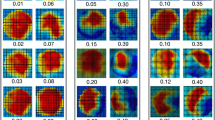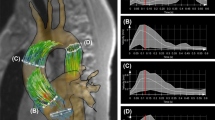Abstract
Shortening the echo times of magnetic resonance (MR) sequences used for phase-shift velocity mapping to 3.6 ms has extended use of the technique to measurement of velocities in turbulent, poststenotic jet flows. We used a 0.5-T MR machine and field even-echo rephasing (FEER) sequences with 3.6 ms echo times for jet velocity mapping.In vitro trials used continuous flow through a phantom with a 6-mm stenosis. Fifteen patients with mitral and/or aortic valve stenosis and 20 patients with repaired aortic coarctation were studied prospectively, with Doppler ultrasonic measurement of peak jet velocity performed independently on the same day. The clinical contribution of MR jet velocity mapping, used during a 3-year period in 306 patients with congenital and acquired disease of heart valves, great vessels, and conduits, was assessed retrospectively. The 3.6-ms sequence allowed accurate measurement of jet velocities up to 6 m s−1 in vitro (r=0.996). Prospective studies in patients showed good agreement between MR and Doppler measurements of peak velocity:n=38; range, 1.2–6.1 m s−1; mean, 2.7 m s−1; mean of differences (Doppler-MR), 0.22 ms−1; standard deviation of differences, ±0.38 m s−1 (±14%). MR jet velocity mapping proved particularly valuable for assessment and localization of stenoses at sites where ultrasonic access was limited. The technique represents a diagnostic advance which can obviate the need for catheterization in selected cases.
Similar content being viewed by others
References
Moran PR (1982) A flow velocity zeugmatographic interlace for NMR imaging in humans.Magn Reson Imaging 1 197–203.
Nayler GL, Firmin DN, Longmore DB (1986) Blood flow imaging by cine magnetic resonance.J Comput Assist Tomogr 10 715–722.
Underwood SR, Firmin DN (1991)Magnetic Resonance of the Cardiovascular System. Oxford: Blackwell Scientific Publications.
Mostbeck GH, Caputo GR, Higgins CB (1992) MR measurement of blood flow in the cardiovascular system.Am J Radiol 159 453–461.
Kilner PJ, Firmin DN, Rees RSO, Martinez JE, Pennell DJ, Mohiaddin RH, Underwood SR, Longmore DB (1991) Valve and great vessel stenosis: Assessment with MR jet velocity mapping.Radiology 178 229–235.
Kilner PJ, Manzara CC, Mohiaddin RH, Pennell DJ, Sutton MStJ, Firmin DN, Underwood SR, Longmore DB (1993) Magnetic resonance jet velocity mapping in mitral and aortic valve stenosis.Circulation 87 1239–1248.
Martinez JE, Mohiaddin RH, Kilner PJ, Khaw K, Rees RSO, Somerville J, Longmore DB (1992) Obstruction in extracardiac ventriculopulmonary conduits: Value of magnetic resonance imaging with velocity mapping and Doppler echocardiography.J Am Coll Cardiol 20 338–344.
Mohiaddin RH, Kilner PJ, Rees RSO, Longmore DB (1993) Magnetic resonance volume flow and jet velocity mapping in aortic coarctation.J Am Coll Cardiol 22 1515–1521.
Sampson C, Kilner PJ, Hirsch R, Rees RSO, Somerville J, Underwood SR. (1994) Venoatrial pathways after Mustard operation for transposition of the great arteries: anatomic and functional imaging. Radiology193: (in press).
Sondergard L, Thomsen C, Stahlberg F, Gymoese E, Lindvig K, Hilderbrandt P, Henriksen O (1992) Mitral and aortic valvular flow: quantification with MR phase mapping:J Magn Reson Imaging 2 295–302.
Sondergard L, Stahlberg F, Thomsen C, Stensgard A, Lindvig K, Henriksen O (1993) Accuracy and precision of MR velocity mapping in measurement of stenotic cross sectional area, flow rate and pressure gradient.J Magn Reson Imaging 3(2): 433–437.
Eichenberger AC, Jenni R, von Schultess GK (1993) Aortic valve pressure gradients in patients with aortic valve stenosis: quantification with velocity-encoded cine MR imaging.Am J Radiol 160 971–977.
Author information
Authors and Affiliations
Rights and permissions
About this article
Cite this article
Kilner, P.J., Firmin, D.N., Mohiaddin, R.H. et al. Short-echo-time magnetic resonance phase-shift velocity mapping for assessment of heart valve and great vessel stenoses: three years' experience. MAGMA 2, 339–342 (1994). https://doi.org/10.1007/BF01705266
Issue Date:
DOI: https://doi.org/10.1007/BF01705266




